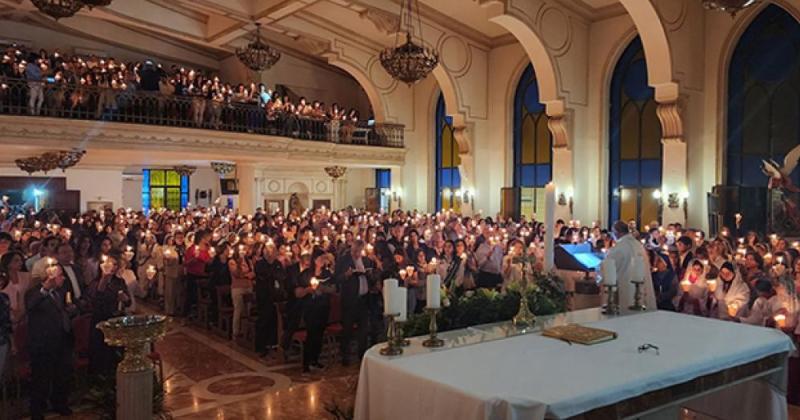First: It is painful to celebrate Easter in two stages, especially this year, as the difference in timing between the two Western calendars, namely the Julian and the Gregorian calendars, has been five weeks. The matter is not in the hands of the current heads of churches. They actually inherited this or that calendar at a time when the quest for comprehensive unity remains elusive. May God forgive "the full moon" that made its quick guest appearance after marking spring, which elicited an early celebration in the Western calendar. Thus, the people who follow the Eastern calendar had to wait until this moment as we needed to wait for the full moon, which was delayed.
By the way, next year 2025 marks the 1,700th anniversary of the convening of the Council of Nicaea, which approved the law for celebrating Easter. It is hoped that the hearts will converge in a new Council of Nicaea in which everyone will accept one formula, so as to mark unity in one celebration and true brotherhood, else we will only celebrate the anniversary, cut the Nicaea cake, and celebrate together next year (according to astronomical calculations), and then we will continue to be apart.
Second: Glorious Gaza celebrated Easter according to the two calendars: The Latin Church of the Holy Family marked the Feast of Easter a month ago while and the brotherly Orthodox Church of St. Porphyrius is marking the feast at this moment. It is beautiful, as has been the case during Christmas and also at Easter, to have the priests and their parish councils in each church visit the sisterly church and offer well-wishes to the brotherly priests and the sisterly parishioners, as both share the suffering from the same aggression and danger.
It is an occasion to confirm the Christian presence in Gaza. Though the number is small, yet it is still persistent and has not ceased since the time of Saint Porphyrius in the 4th century, and prior to that since the passage of the Holy Family from Bethlehem to Egypt, passing through Gaza despites the strong winds blowing at the time. Yet, the Christian presence is still persistent although it is diminished, but it is like the presence of salt in food and the light of a shining lamp.
Third: This year, Easter coincides a few days after His Majesty King Abdullah II’s meeting with Pope Francis at the Holy See. This is the 7th visit by His Majesty to the Holy See, during the era of Pope John Paul II, Pope Benedict XVI, and Pope Francis as every one of them visited our holy country. It is an important visit marking the 30th anniversary of the establishment of diplomatic relations in 1994 between Jordan and the Holy See, during the era of Pope John Paul II and King Hussein Ibn Talal, may his soul rest in peace. This was preceded 30 years earlier by the visit of Pope Paul VI in 1964.
Furthermore, the Royal visit takes place 10 years after the visit of Pope Francis, and coincides with Jordan’s celebration of the silver jubilee of the ascension of the “Dean of Arab Leaders,” who has been repeatedly calling for consolidating brotherhood and harmony among religions, and for an immediate ceasefire, which is a matter where the diplomacy of the Vatican on the one hand concurs with the calm and peaceful diplomacy of the Kingdom of Jordan which we look forward for more in the Jordan of goodness and holiness.
Fourth: The churches are illuminated on the night of a Holy Saturday named 'light'. It is not just a torch that we carry in our hands and walk around, with my appreciation for the traditions that are still persistent in our hearts and consciences. Saturday night used to be called the “Easter Vigil,” when the main Church of Jerusalem, namely the Church of the Holy Sepulcher, used to be lit with three reed candles. Fr. Dr. Aziz Halawa told us about this in his wonderful book: “The Church of the Holy City and its Liturgy in the First Five Centuries.” It is at a time in those centuries when the church hymns resound: “We now know the merits of this pillar of candle, and the time has come for us to light it to the glory of God, a bright fire.” God willing, we will talk about this book in another article.
Fifth: Regarding the story relevant to the light of churches, a few days ago I was invited to a special occasion to a friend from “Bani Ma’rouf”, namely Jordan’s historic Druze who bear witness to the Kingdom’s respect for all those religious and ethnic origins. When they started singing popular songs, I heard a song that said: “From Najd to Bani Sabis, the ones with the white turban, that are like the lights of the Churches.”
This simile is beautiful, as it is related to those who wear the pure, and flawless white turban. The fathers and grandfathers found a suitable simile for it, namely the light of the churches, which is actually derived from Holy Saturday of Light which sparkles with the most beautiful lights. Yet, the most beautiful light that shines in the human heart is the light of brotherhood and love for all.
May you have permanent light and white hearts that resemble the light of churches.
